Terzo giorno per b.Class, la serie di workshop di danza tenuti per B.Motion 2013 dai coreografi e danzatori presenti al festival. Sabato 24 agosto la lezione, dalle 10 alle 12 alla Palestra Vittorelli, è stata condotta da Sharon Fridman.
Ogni giorno pubblicheremo le immagini della lezione, alcuni commenti dei partecipanti e un’intervista ai coreografi!
INTERVISTA A SHARON FRIDMAN: 5 domande al coreografo che ha condotto la B.Class
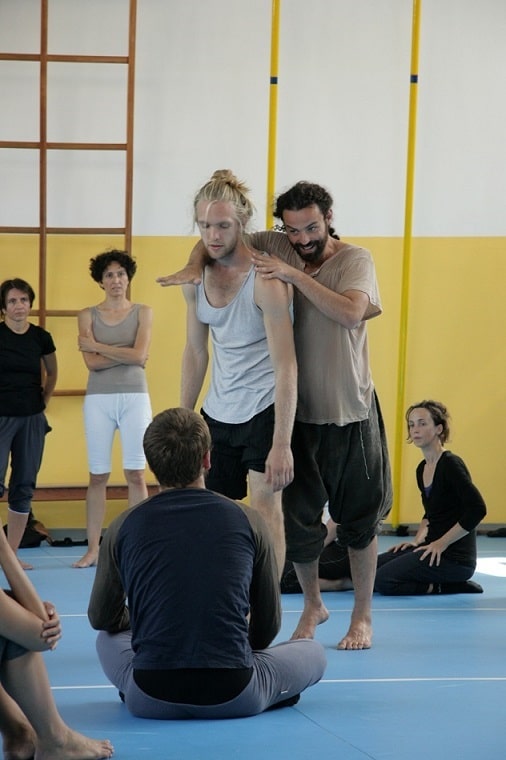
I dance since I was 8, I’ve never stopped, and it is true that I’ve made a lot of different classes and techniques in Israel but also around the world. As a dancer, in a moment of my history, I’ve lost the reason to dance; I didn’t understand why I danced, and I wondered what that form that I make when I dance is, why and what the relationship with the life is, how it can help the universe, why somebody has to do this…. These were my questions. When I danced with Vertigo Dance Company and with the choreographer Noa Wertheim I’ve understood something about the relationship between dance and life. There is something in Noa that I respect a lot.
The other one is my mother: she has problems of balance and she always falls, she always searches something to make her stable. When I was a child I was always around my mother and it was always a moment that she fell and I had to take her up. After making the contact I’ve understood the relationship between the contact and the life, the relationship with my mother and this gave me a reason why to dance and what the real relationship between dance and life is. So I think that my mother is the life and to get her is my ispiration for the dance.
Is there an experience which impressed you or is particular important for you?
When I see a dance work with its true, finding the relationship between his movement and his life, this is for me interesting. Maybe somebody makes some very interesting technique, like for example José Limón Dance; this technique is interesting only when he works with this technique, because I can undestand the relationship between his technique and his life. It is not a technique for dance in general, I don’t believe in this, because there are millions of dancers in the world but only some of them really succeed to bring something really personal to the work. I see this achievment in people that have found a relationship between the technique they have – classical, contemporary, jazz, hip hop… – and their life. This is for me the true.
How have you structured your class here in B.Motion?
It was very complicated for me, because I’ve never given one class for two hours. Usually it is a workshop of one week, with everyday six hours in which we speak about the philosophy, about the relationship between dance and life… while in two hours you have to put everything in one little moment. So I’ve chosen some exercises and it doesnt’ matter what the exercise is; it is important what there is between the exercises, how I explain the philosophy and the reason for making the exercise, how this exercise related to life.
Describe your B.Motion’s class in a sentence.
Not enough but deep because I tried to be as much deep as I can in a very little time.
Is there something that you or people in general have not to do during a dance workshop?
Not to plan. Not to plan the form, it is important really to let you go and try to absorbe everything.
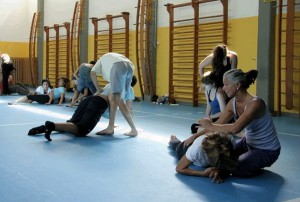 |
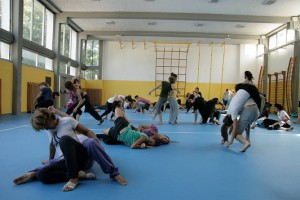 |
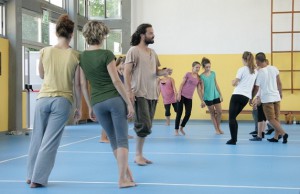 |
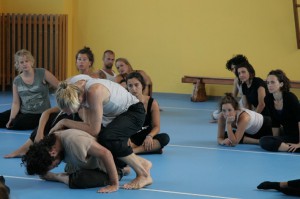 |
COMMENTI DEI PARTECIPANTI
La contact è un lavoro molto difficile, c’è bisogno di collegarsi con il centro dell’altra persona, unificare i respiri e i movimenti per trovare gli impulsi per muoversi insieme. Non è una cosa che si impara in un giorno, però Sharon è fantastico! Floor
Abbiamo lavorato a coppie, per esempio l’ultimo esercizio che abbiamo fatto è stato sul centro che loro chiamano tango: bisognava lasciarsi andare sul centro del proprio partner sia andando avanti sia con tre passi indietro. La difficoltà stava semplicemente sul fatto di sentirsi e respirare assieme che sembra una banalità ma in realtà è molto difficile. Poi mi son trovata con Sofia, che ho conosciuto qua e con cui ho condiviso l’esercizio; lei fa danza da tanti anni e io invece vengo da un’altra formazione per cui bisognava trovare il giusto linguaggio per capirci, è stato bello! Samanta
Sharon Fridman
Di origini israeliane, è attivo a Madrid e attualmente direttore del gruppo Projects in Movement.
È interprete per prestigiose compagnie quali Ido Tadmor Dance Company di Tel Aviv, Kibbutz Contemporary Dance Company, Vertigo Dance Company e per diversi progetti per il Suzanne Dellal Center. Il suo lavoro come coreografo ha avuto inizio nel 2000 con la costituzione del Phrasal group, e le creazioni Covered red (2000) e Anna (2001), Waiting (2003), The Creation (2004), Play Boy (2005), Carlos & Me (2007), Q Project (2008), Shakuff (2010) e Al menos dos caras (2011). Nel 2008 ha partecipato a Dance Lines 8. Nel 2009 è invitato a prendere parte a Choreoroam, un importante progetto di ricerca coreografica, durante il quale ha sviluppato il solo Beyond rappresentato al Dance Week Festival di Zagabria (Croazia) e a Operaestate. Tra le sue ultime partecipazioni spicca la collaborazione artistica con Operaestate per cui ha creato Shalosh. Ha ricevuto riconoscimenti quali l’Alicia Alonso CIC’2012, il premio per la migliore proposta di danza contemporanea all’International Dance and Theatre Fair of Huesca 2011, il primo premio al Choreography Contest Burgos, New York 2011.
*La redazione di b-stage 2013 è composta da Elena Conti, Roberta Ferraresi, Rossella Porcheddu, Carlotta Tringali